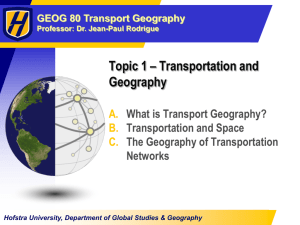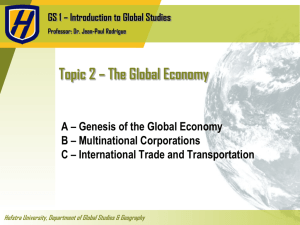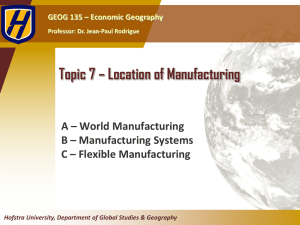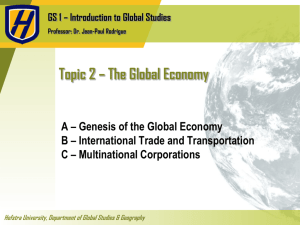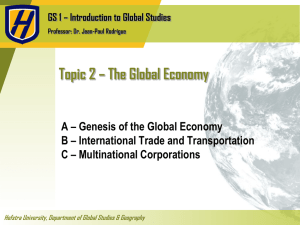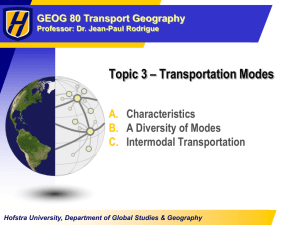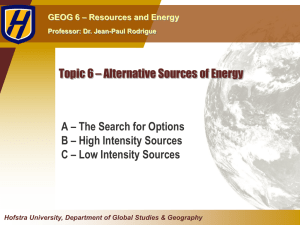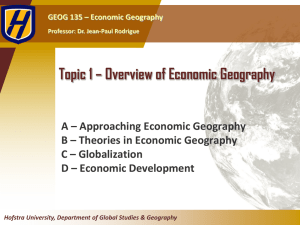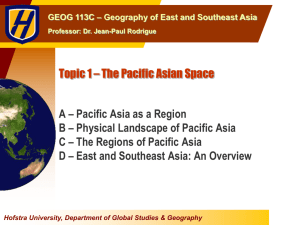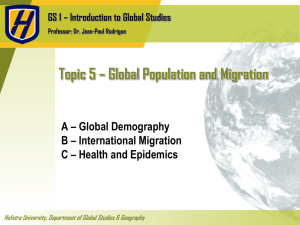Topic 2 - Historical Developments of Capitalism
advertisement
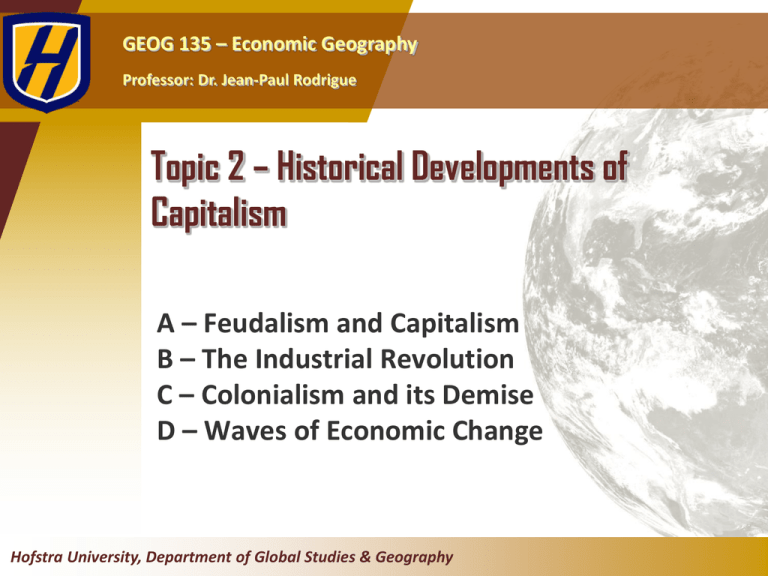
GEOG 135 – Economic Geography Professor: Dr. Jean-Paul Rodrigue Topic 2 – Historical Developments of Capitalism A – Feudalism and Capitalism B – The Industrial Revolution C – Colonialism and its Demise D – Waves of Economic Change Hofstra Department of Global Studies & Geography HofstraUniversity, University, Department of Global Studies & Geography A - FEUDALISM AND CAPITALISM 1. 2. The Feudal System and its Demise Long Distance Trade © Dr. Jean-Paul Rodrigue 1. The Feudal System and its Demise ■ The Feudal society • A system of bonds and obligations: • • • • Power in land ownership. Administrative/legal (Lord) and religious (Church) control. Rent/Royalties from the serf to the lord (in kind or labor). Fixation of the productive forces (tools and labor) in agricultural production. • Little socioeconomic changes over centuries. • Economy: • Small local markets (fairs). • Low levels of productivity (subsistence level). • Profits taken away by the lord/church, inhibiting any increases in agricultural productivity. • 80 to 90% of the population was in agriculture while the other share were artisans and landowners. • Different types of feudal societies (China, Japan, Europe). © Dr. Jean-Paul Rodrigue Roman Empire, c125AD Empires collapse because of overstretch: resources to maintain hegemony exceed resources collected. Theft, plunder, taxation and (hyper)inflation (final phase). © Dr. Jean-Paul Rodrigue The Silk Road and Arab Sea Routes (8th to 14th Centuries) © Dr. Jean-Paul Rodrigue 1. The Feudal System and its Demise ■ The end of the Middle Ages • The Plague of 1348 created labor shortages and social disruption. • At the end of the 15th century, large parts of Europe were still under a feudal regime: • Trade was almost non-existent because each locality was almost self-sufficient. • Distribution costs were high: • Diversity of currencies. • Different units of measure. • Tariffs imposed on goods moving between small kingdoms. • The emergence of a merchant class (proto-capitalism): • Commodification of goods and services. © Dr. Jean-Paul Rodrigue 1. The Feudal System and its Demise ■ The European origin of the global economy • The fifteenth century marked the beginning of an expansion of European control throughout the world. • Europe progressively assured the development of the global economy by an extension of its hegemony: • Mercantilism was the first phase. • The industrial revolution was the second. • Over three centuries (1500-1800): • • • • • The setting of capitalistic systems. Limits of the world were pushed away. A world where borders are drawn; a delimited world. Establishment of vast colonial empires. Waves of innovations and socio-economic transformations. © Dr. Jean-Paul Rodrigue 2. Long Distance Trade ■ Merchants and Mercantilism • A new structure of wealth accumulation: • Investing in trade and in the manufacture of consumption goods. • Expansion of the wealth of merchants: – It was them, and not the feudal Lords, who had the largest amount of capital. – Merchants invested the capital in commercial enterprises while lords fixed it on land. • Rich merchant families such as the Medici (modern banking). • Goal: • Buy goods at the lowest possible price. • Sell them at the best price, thus generating a profit. • Used to finance new commercial initiatives. • Financing the first maritime explorations: • Attempt to acquire information on the commercial potential of new territories. © Dr. Jean-Paul Rodrigue Early European Maritime Expeditions, 1492-1522 Exploration (inventory of territories and resources). Setting of colonial empires (control of territories). Setting of a global trade network. © Dr. Jean-Paul Rodrigue Density of Ship Log Entries, 1750-1810 © Dr. Jean-Paul Rodrigue 2. Long Distance Trade ■ Trading companies: Private mercantilist tools • From the 17th to the 18th century trading companies acted on behalf of European governments in East Asia. • Joint stock companies. • Guarantied trade monopoly: • Rights paid to their respective governments. • Almost states in themselves: • Had their own ships (military and merchant) and military forces. • Could acquire and manage a foreign territory. • Developed trade links for commodities such as pepper. • Increasingly involved in the control and development of their respective territories. • Faced lack of interest from European governments. © Dr. Jean-Paul Rodrigue 2. Long Distance Trade ■ English East Asian Company • In 1592, a Portuguese ship was captured by England: • Its cargo contained stores of goods from Asia. • Triggered the need to establish a lucrative Asia trade. • EEAC founded in 1599 by British merchants: • Granted a monopoly to trade with Africa, India and America. • Trade structure: • Fill ships with European goods, sail to Asian trade depots. • Sell the goods in exchange of colonial commodities. • Sail back to Europe and sell the goods, cash in and pay dividends to the shareholders. • Dividends were over 10% per year (Sometimes up to 65%). • 25% of the profits coming from the China trade. © Dr. Jean-Paul Rodrigue 2. Long Distance Trade • Constant warfare with French, Dutch and other competitors. • China trade: • From the middle of the 18th century, the company became more involved in trade with China. • European markets needed porcelain, silk and tea. • The company traded silver in exchange. • Opium, grown in India, became a substitute for silver. • Lead to conflicts with China (Opium War of 1844). • Collapse of the EEAC: • Facing intense discontent from other British interests, the company gradually lost its monopolies from 1813. • Dissolved in 1874. • Holdings transferred to the British Crown which appointed Governors. © Dr. Jean-Paul Rodrigue 2. Long Distance Trade ■ Dutch East India Company • The first Dutch expedition the Indonesia took place in 1595. • Founded in 1602 by Dutch merchants: • The world’s first multinational corporation. • Conquest: • • • • Gained a foothold in Batavia (Indonesia; 1610). Conquest of most of the island of Ceylon (Sri Lanka; 1640). Took Malacca from the Portuguese (1641). Sunk all vessels they found in Indonesian waters, removing competition. • Impacts: • Replaced local trading networks with their own. • Established fortified trading posts. • Founded Cape Town (South Africa; 1650) as a stage for the long Europe-Asia voyage. • Took advantage of feuding Indonesian dynasties by arming allies and gaining territorial rights. © Dr. Jean-Paul Rodrigue 2. Long Distance Trade • Plantations: • Forced the introduction of new cultures such as coffee in West Java (1711). • Monopoly on nutmeg (meat preserver) and cinnamon. • Destroying spice production on uncontrolled islands. • One of the first true multinational corporation: • • • • By 1750, employed around 25,000 people. Business in 10 Asian countries. Built 1,500 ships. Made 5,000 voyages to Asia. • Bankruptcy in 1799: • Corruption and mismanagement. • Holdings transferred to the Dutch Crown which appointed Governors. © Dr. Jean-Paul Rodrigue Dutch East India Company, Trade Network, 17th Century © Dr. Jean-Paul Rodrigue Major Global Trade Routes, 1400-1800 © Dr. Jean-Paul Rodrigue B - THE INDUSTRIAL REVOLUTION 1. 2. The European Origins of the Industrial Revolution A “Revolution” in Industry © Dr. Jean-Paul Rodrigue 1. The European Origins of the Industrial Revolution ■ Why Europe? • Competition: • Political fragmentation (monarchies and republics). • Divided into competing corporate entities (early multinationals). • The Scientific Revolution: • 17th century breakthroughs in mathematics, astronomy, physics, chemistry and biology. • The Rule of Law and Representative Government: • Private-property rights. • Representation of property owners in elected legislatures. • Modern Medicine: • Breakthroughs in health care (19th and 20th centuries). • Drop in death rates and increase in life expectancy. © Dr. Jean-Paul Rodrigue 1. The European Origins of the Industrial Revolution • Consumer Society: • Supply of productivity-enhancing technologies. • Demand for more, better, and cheaper goods. • Work Ethic: • Combine more extensive and intensive labor. • Higher savings rates; sustained capital accumulation. © Dr. Jean-Paul Rodrigue 2. A “Revolution” in Industry ■ Emergence • Started at the end of the 18th century (1750-1780). • Economic and social transformations first observed in England. • Demographic transition of the population: • Fast growth rate. • Improvements in sanitary conditions and hygiene. • Why speak of “revolution” for a process occurring over on more than 150 years? • At the scale of the world’s economic history, the industrial revolution radically changed the foundations of economic systems. • It established the foundations of the global of the economy. • Most of the technical innovations took place on a short period, mainly between 1760 and 1800. © Dr. Jean-Paul Rodrigue 2. A “Revolution” in Industry ■ Technological innovations • New methods of production by trials and errors: • New materials (steel, iron, chemicals). • Substitution of machines to human and animal labor. • Usage of thermal energy to produce mechanical energy. • Changes in the nature production and consumption: • Textiles. • Steam engine. • Iron founding. • Production (factory): • • • • The first factories appeared after 1740. Division of labor. Increased productivity within a factory system of production. Location (initially waterfalls and then coal fields). © Dr. Jean-Paul Rodrigue Major Technological Innovations of the Industrial Revolution Power Generation Textiles Metallurgy Transportation Thermal energy used for mechanical energy Mechanization of spinning and weaving Mass production of steel (shipbuilding, rails, construction and machines) Modern transport and telecommunication systems • • • • • • • First water pump (1712) in mines. Watt (1769); significant improvements. Steam locomotive (1824). Electric generator (1831). Steam turbine (1884). Electric motor (1888). Diesel engine (1892) • • • • • • “Flying shuttle” (1733) doubled weaving productivity. “Spinning jenny” (1765). “Water frame” (1768); hydraulic power. “Spinning Mule” (1779); steam power. Cotton gin (1793). Sewing machine (1846). • • Coke instead of coal for iron production (1709). Bessemer process (1855). • • • • • • Railroads (1825). Telegraph (1836). Steamship (1838). Transatlantic cable (1866) Telephone (1876). Airplane (1903). © Dr. Jean-Paul Rodrigue Geographical Impacts of the Suez and Panama Canals © Dr. Jean-Paul Rodrigue Productivity in the Textile Industry, Great Britain , 1829-1882 1000 120 900 100 800 700 80 600 500 60 400 40 300 200 20 Production per worker 100 Hours 0 0 1829-1831 1844-1846 1859-1861 1880-1882 © Dr. Jean-Paul Rodrigue Turnpikes in Great Britain, Late 18th and Early 19th Century 35,000 30,000 25,000 Km 20,000 15,000 10,000 5,000 0 1650 1700 1750 1800 1850 © Dr. Jean-Paul Rodrigue American Rail Network, 1861 © Dr. Jean-Paul Rodrigue Global Telegraph System, c1901 (the Victorian Internet) © Dr. Jean-Paul Rodrigue 2. A “Revolution” in Industry ■ Agriculture • A second agricultural revolution. • Introduction of new food sources: • The potato could account for 22% of the post-1700 increase in population growth. • Crop rotation, selective breeding, and seed drill technology. • Less agricultural population. • Growth of the production of food. • Mechanization and fertilizers: • Combine (McCormick, 1831). • Scientific and commercial agriculture (crop rotation). • Declining food prices. © Dr. Jean-Paul Rodrigue 2. A “Revolution” in Industry ■ Social changes • Significant urbanization: • Migration from the countryside to cities. • By 1870 more of the half of the population of the first industrial nations was no longer in the agricultural sector. • England had reached this stage since 1820. • Towards 1901, 75% of the English population lived in cities. • Creation of a labor class: • Exchange of labor for a wage. • London: • Counted for half a million inhabitants in 1700. • Reached a million during the first English census of 1801. © Dr. Jean-Paul Rodrigue Share of the Population in Agriculture, Early Industrial Countries, 1820-1910 90 80 70 60 Great Britain France Germany United States 50 40 30 20 10 0 1820 1850 1870 1910 © Dr. Jean-Paul Rodrigue 2. A “Revolution” in Industry ■ Consequences of the industrial revolution • Setting of high capacity maritime and inland transport systems. • Scramble to capture remaining territories. • Consolidation of colonialism: • • • • First Opium War in 1839. Opening of Japan in 1853. Consolidation of British Raj in 1858. “The Scramble for Africa” in 1890s. © Dr. Jean-Paul Rodrigue C – COLONIALISM AND ITS DEMISE 1. 2. Colonial Economic Systems The Demise of Colonialism © Dr. Jean-Paul Rodrigue 1. Colonial Economic Systems ■ Colonialism • Quest for riches and profit • The most important factor. • Early colonialism was a capitalist venture. • Religious and racist drive: • A moral justification. • Support of the church. • Military technology advantages: • Better guns. • Better ships (artillery). • Two waves of colonialism: • First wave: Mercantilism (1415 – 1815); independence of the Americas. • Second wave: Industrial revolution (1815-1969). © Dr. Jean-Paul Rodrigue Colonial Trade Pattern, North Atlantic, 18th Century © Dr. Jean-Paul Rodrigue Intermediate Globalization: The British Empire, 1897 20% of the world’s surface 25% of the world’s population © Dr. Jean-Paul Rodrigue Global Colonial Empires, 1900 © Dr. Jean-Paul Rodrigue 1. Colonial Economic Systems ■ Impacts of colonialism • Annihilation and displacement of indigenous populations: • 90-95% of the population died because of disease (e.g. smallpox) and wars. • Forced migration through slavery (Africa) or contract workers (Southeast Asia). • Development of the primary sector: • Export-oriented plantations (sugar, cotton, tea, coffee, fruits, rubber, tobacco, etc.). • Suppressing industrialization (economic dependency). • Dual society: • Ruling elite class (sometimes a minority). • Population in servitude (e.g. taxation). • Artificial boundaries: • “Balkanization”. © Dr. Jean-Paul Rodrigue World Trade Routes, 1912 © Dr. Jean-Paul Rodrigue European Control of the World, 1500-1950 1800 (37%) 1878 (67%) 1913 (84%) © Dr. Jean-Paul Rodrigue 2. The Demise of Colonialism ■ Decolonization • Emerging nationalisms and patriotisms. • Successful first wave of independence in the Americas after the Napoleonic Wars (late 18th, early 19th century) • Influence of Marxism-Leninism in explaining past oppression. • Japan’s impact in Pacific Asia during WWII. • Nationalism was the driving force: • Upheld by leaders such as Bolivar (Latin America), Sun Yat-sen (China), Mao Zedong (China), Ho Chi-Minh (Vietnam) and Sukarno (Indonesia). • Created a wide variety of post-colonial governments and ideologies. © Dr. Jean-Paul Rodrigue Decolonization since 1945 1945-1959 1960-1969 Since 1970 © Dr. Jean-Paul Rodrigue D – WAVES OF ECONOMIC CHANGE 1. 2. Socioeconomic Changes Technological Changes © Dr. Jean-Paul Rodrigue Political-economic Forms of Globalization: Imperialism, Mercantilism and Capitalism Imperialism Mercantilism Capitalism Definition Expansion by territorial conquest Control and monopoly of the trade of commodities Generation and accumulation of capital Growth Domination and subordination Unequal trade Productivity (profit) Agent Military State Corporation Main relation Tribute / trade Trade / taxes Transactions Territories Protectorates Colonies Markets Example Roman Empire Dutch East India Company Ford © Dr. Jean-Paul Rodrigue Major Phases of Socioeconomic Change Stone Age Feudalism Industrial Planetary Organization Tribe / Village City-state, Kingdom Nation-state Global governance Economy Hunting and gathering Settled agriculture Industrial system Globalization Communication Language Writing Printing Internet © Dr. Jean-Paul Rodrigue Long Wave Cycles of Innovation Mass Production Pace of innovation Industrial Revolution Water power Textiles Iron 1785 60 years Post Industrial Steam Rail Steel 1845 Electricity Chemicals Internal-combustion engine 55 years 1900 50 years Petrochemicals Electronics Aviation 1950 40 years Digital networks Software New Media 1990 30 years © Dr. Jean-Paul Rodrigue Long Run Productivity Growth Commodity 1-speed Bicycle Time to earn 1885 (hours) Time to earn 2000 (hours) Productivity multiple 260 7.2 36.1 Office chair 24 2.0 12.0 Hair brush 16 2.0 8.0 Silver Spoon 26 34.0 0.8 © Dr. Jean-Paul Rodrigue Cumulative Waves of Transport Development Sailships Canals Railways Highways Airports (17-18th century) Empires and global trade networks (19th century) Inland access (19-20th century) Inland and national accessibility (20th century) National mobility systems Suburbanization (20-21st century) Global mobility systems © Dr. Jean-Paul Rodrigue Primary Energy Production by Source, United States, 1750-2010 25,000,000 Coal Biomass Petroleum Natural Gas Hydroelectric Nuclear Billion BTU 20,000,000 15,000,000 10,000,000 5,000,000 0 1750 1800 1850 1900 1950 2000 © Dr. Jean-Paul Rodrigue
